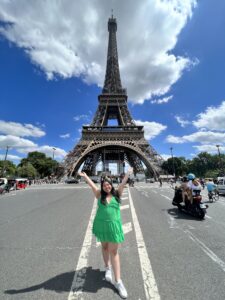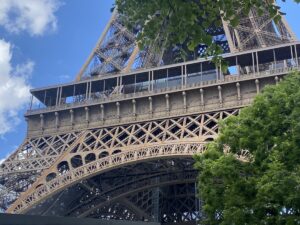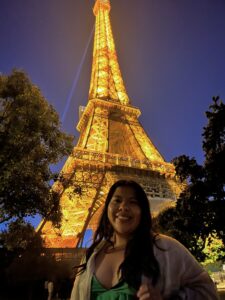
Following a busy week of assignments– two papers and a small presentation later– my roommate and I were ready for the weekend! Before arriving in Paris, Solanch, Jewel, and I booked a tour of the Eiffel tower and it turned out to be the perfect adventure after a long week. During the first three weeks in Paris, Solanch and I enjoyed seeing the Eiffel tower twinkle from our apartment kitchen each night before bed. We knew we wanted to enjoy the beauty of the tower as much as possible, so we decided that we would take full advantage of our visit and spend the entire day in the area. While we have gotten the chance to study at the accent center, the nearby cafes, and even the Sainte-Geneviève library, we wanted to experience studying with the tower in the background. We decided that the view would inspire us as we worked on our assignments so we brought our computers to get ahead on some readings.

As we walked toward the tower, we learned that Gustave Eiffel’s apartment could be found at the top of the tower. Apparently, the space was used to accommodate his guests and work on scientific experiments– how cool is this? As I heard this, I thought to myself: I wouldn’t mind the commute every morning! Before reaching the lines to start our ascension, we could already see the Eiffel tower in all of its glory. It towered 1083 feet above us and was even more breathtaking up close. As we got closer and closer, our tour guide pointed out the names that bordered the four sides of the tower. Apparently, the names of 72 scientists, including mathematicians and engineers, were inscribed along the four sides of the tower. I wondered if there were any neuroscientists that had made the cut. A quick google search told me that Marie-François Xavier Bichat, although not a neuroscientist by training, was an anatomist who made substantial contributions that were later used for the development of neuroscientific understanding. He is most recognized for establishing the Medical Society of Emulation and for his publications titled: Physiological Researches on Life and Death and General Anatomy Applied to Physiology and Medicine (Clara et al., 2012). Through many*** dissections of corpses, he was able to identify 21 different types of elementary tissues. All of this was done without the use of a microscope! Pretty remarkable! I love how history is so integrated and evident all throughout Paris. I can’t believe that we have a little over 1 week left of this incredible experience!

Clarac, F., Barbara, J.-G. ., Broussolle, E., & Poirier, J. (2012). Figures and institutions of the neurological sciences in Paris from 1800 to 1950. Introduction and Part I: Neuroanatomy. Revue Neurologique, 168(1), 2–14. https://doi.org/10.1016/j.neurol.2011.08.013
